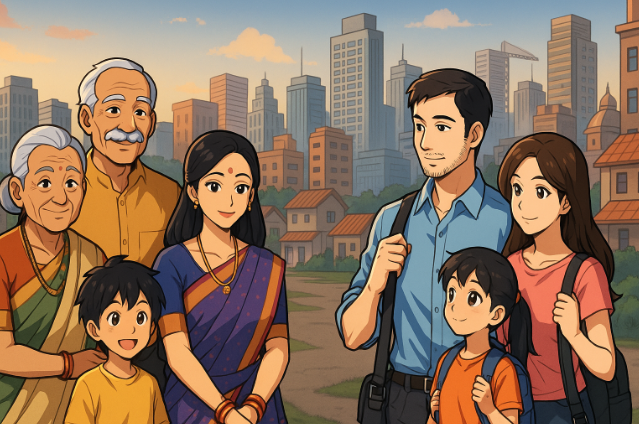
Family — a word that comprises all the members and individuals in a specific home. There is no specific number; a family can be made up of two members or a group of people living together. With changing times, evolving work culture, and rapidly changing living patterns, families have been categorised into two types: joint family and nuclear family. A joint family comprises many members, while a nuclear family typically includes a father, mother, son, and daughter.
A joint family is a traditional family system where multiple generations — like grandparents, parents, children, and sometimes uncles and aunts — live together under one roof. This setup promotes strong emotional bonds and shared responsibilities. In a joint family, values like respect for elders, cooperation, and unity are naturally cultivated. Children grow up surrounded by love, guidance, and cultural teachings from multiple elders, which shape their personality and morals. Financial responsibilities are shared, reducing the burden on individuals and ensuring stability during tough times. Joint families also provide emotional support during challenges, creating a sense of belonging and security. Celebrations and festivals are more vibrant in such families. The importance of joint families in preserving traditions and offering social security remains unmatched. They teach us to live selflessly and value relationships, making them an essential part of culture and tradition.
The traditional Indian joint family, once the cornerstone of our social structure, is gradually fading away. Factors such as rapid urbanisation, economic independence, changing aspirations, and migration for education and jobs have contributed significantly to this shift. Today, nuclear families comprising just parents and children are becoming the new norm, especially in cities and urban centres. With higher education and career opportunities drawing young people away from their hometowns, maintaining a joint family becomes difficult. Moreover, rising living costs, space constraints in cities, and the desire for privacy and autonomy also drive the preference for smaller families.
In place of joint families, we now see nuclear households supported by virtual connections and paid caregiving systems. Elderly care, once a natural duty of joint families, is increasingly outsourced to old-age homes or home care services. Emotional support, earlier found within the household, is now often sought through friends, therapy, or online platforms. Parenting has also evolved. Without the guidance of elders, young couples rely more on books, social media, or parenting apps. Financial independence has reduced the need for pooling resources, making people feel more self-reliant but often more isolated. The work-from-home culture and hectic urban life leave little time for extended family bonding. Cultural rituals, once celebrated collectively, have become low-key or symbolic. While nuclear families offer flexibility, independence, and personal space, they sometimes lack the emotional cushion and cultural grounding that joint families provide. This transition has impacted not only individual lifestyles but also community values, leading to more individualistic attitudes.
However, not all is lost. Some families are trying to revive the essence of joint living through frequent reunions, group vacations, or even shared housing models where cousins or siblings live in the same apartment complex. Technology helps bridge the distance, but it cannot fully replace the warmth of shared meals, multi-generational wisdom, and collective celebrations. Joint families have the privilege of having multiple generations to converse with. Children have grandfathers and grandmothers to tell stories of their childhood. These stories are full of life lessons and have a huge impact on the upbringing of children. Joint families also have a lot of relative connections who can show up anytime in difficult situations like medical emergencies or financial issues. They also have the privilege to plan long trips to various religious and tourist places where the whole family travels together and shares quality time. Financial burdens are eased as expenses are shared, making it easier to manage daily needs and emergencies. Joint families promote teamwork, patience, and compromise — qualities essential for personal growth. Celebrations and festivals are more joyful and grand, enhancing family bonding. In times of crisis, the emotional strength of a joint family is unmatched, providing security and unity. Overall, a joint family nurtures togetherness, strengthens relationships, and fosters a sense of belonging that is often missing in nuclear setups.
Nuclear families can shift to joint families by developing a mindset of togetherness, cooperation, and shared living. The first step is open communication among family members, especially siblings and parents, about the benefits of living together — such as emotional support, shared responsibilities, and better care for elders and children. Planning practical aspects like financial contributions, personal space, and household duties is essential to avoid conflicts. Families can start by staying together temporarily during festivals or vacations, gradually increasing the duration to build comfort and understanding. Choosing larger homes or shared apartment complexes can also ease the transition. Technology can help coordinate routines and responsibilities, while mutual respect and flexibility are key to maintaining harmony. Encouraging intergenerational bonding through shared activities and open discussions can strengthen ties. With willingness and proper planning, nuclear families can successfully transition into joint families, reviving the essence of unity and collective living in today’s fast-paced world.
In the upcoming times, the world will be fast-paced and tech-driven. There will be many financial obstacles, and individuals must have emotional support from their families. While nuclear families provide some support, it may not be sufficient to handle challenges with ease. Here, the real importance of joint families comes into the picture. There are many reasons to be apart and form a nuclear family, but there are fewer — yet deeply meaningful — reasons to stick with a joint family. These few reasons are life-worthy. One might feel that joint families are somewhat chaotic, but in the end, only an individual and their peace of mind can truly handle the world. And for that peace of mind, a joint family must be there for every member of the generation.
